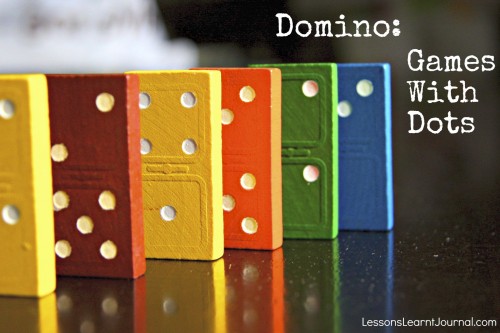
Domino: Games with Dots
Domino has been played in classrooms for generations. The humble dots are an amazing tool used to help young children construct their understanding of number relationships; no small task by any means.
Numbers can be partitioned into other numbers. Eg, 6 can be partitioned into 3 and 2 and 1. The more part-whole number relationships a child grasps, the more flexible they can be in their mental strategies for solving complex mathematical computations.
Subitising provides a basis for enhancing a child’s knowledge of part-whole number knowledge, which has implications for learning basic number facts.
Domino games and other games with dots, help children learn to subitise; supporting their development of both spatial and number sense.
Game with Dots #1: Domino Flip
1. Place dominoes face down.
2. Flip over one domino at a time.
3. Encourage the child to immediately state the number of dots on each side of the domino without counting.
4. If they are correct, then they keep the domino; if not, the domino is flipped face down again.

Scaffold the Learning
So much of a young child’s introduction to mathematics involves counting. Although counting is an important skill, we often ignore the spatial sense of a child, (their ability to think in dynamically visual ways).
N & M are typical examples of this. They were so used to counting that when presented with the dominoes and asked to state the number of dots without counting, all they wanted to do was count the dots.
Scaffold this activity for learners who can’t immediately state the number of dots without counting, by presenting two numbers for them to choose from, and asking them to estimate which one seems the right number for the dots presented. Eg there are four dots on one side of the domino. Ask the child, is there one dot or four dots? Without counting, encourage them to take that risk and make an educated guess. Then count the number of dots to check if they were right.
Extend the Learning
You can extend this further by asking for the number of dots on each side of the domino and then the total. The emphasis here is to encourage them to immediately state the number of dots, without counting.
Game with Dots #2: Traditional Game of Domino
Working together or individually, link dominoes together.
Remind children that dominoes can only be linked if their numbers match.
Again, the emphasis here is to encourage them to immediately state the number of dots without counting.

A Few Notes on Subitising
Pre-school children can typically subitise arrangements of up to four objects.
Perceptual subitising is the ability to simply recall a number name of a given spatial arrangement of objects. Eg, they can instantly recognise that there are six dots without having to count the dots.
Conceptual subitising is the ability to partition a spatial arrangement into its composite parts and recognise the whole. Eg the six dots are made up of 3 and 3; or 5 and 1; or 4 or 2.
N & M: 4 years, 2 months
August 2012
Check out our Maths for Under 5’s activities.
















